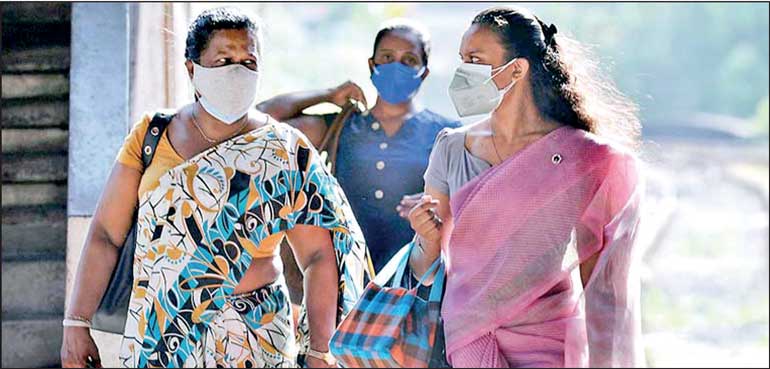Sunday Dec 14, 2025
Sunday Dec 14, 2025
Friday, 5 April 2024 00:26 - - {{hitsCtrl.values.hits}}

In almost all sectors and occupations, women tend to earn, on average, less than men, despite generally having higher educational attainments – Pic by Shehan Gunasekara
 In most countries around the world, women earn substantially less than men. At the global level, the gender pay gap is estimated at 20%. This issue concerns countries across all geographical regions, regardless of their stage of economic development.
In most countries around the world, women earn substantially less than men. At the global level, the gender pay gap is estimated at 20%. This issue concerns countries across all geographical regions, regardless of their stage of economic development.
During the last decade, the attention towards the reduction of the gender pay gap has considerably increased. The United Nations Sustainable Development Goals explicitly mention the objective of equal pay for work of equal value for women and men (target 8.5). Multi-stakeholder international coalitions, such as the Equal Pay International Coalition, have been established to help countries make progress in the reduction of gender wage inequalities. These international efforts have been matched by a series of country-level initiatives involving governments, trade unions and employers. Sri Lanka has also ratified the ILO Equal Remuneration Convention (No.100) an international labour standard seeking to achieving pay equity.
In this context, a new report published by the ILO, ‘The Gender Pay Gap in Sri Lanka: A Statistical Review with Policy Implication’ shows that gendered wage differentials are still persistent in Sri Lanka and surpass the global average.
After accounting for differences in the distribution of female and male employment in the labour market, the analysis shows that women still earn, on average, 27% less than men for one hour of work. This percentage has varied little over the last decade. Moreover, these wage differentials cannot be explained by differences in the characteristics of women and men in employment (such as, differences in age, educational attainments or sector and occupation). Rather, they are entirely unexplained by observable factors, and are likely driven by gender-based discrimination in the labour market.
The report also shows that gender wage differentials are higher among low-skilled individuals, and for people working in the informal economy. In contrast, gender wage differentials are smaller in the public sector, where wages are often determined following a more objective and transparent wage determination process.
However, across virtually all groups and in almost all sectors and occupations, women tend to earn, on average, less than men, despite generally having higher educational attainments. This points to historical undervaluing of work deemed ‘women’s work’ – such as care jobs, teaching, etc. – and occupational segregation of women in a smaller range of jobs and occupations.
Renewed policy efforts and actions are required to reduce the gender pay gap in Sri Lanka. Evidence shows that pay transparency legislation can contribute to lowering gender wage differentials, while also increasing women’s knowledge of the wages associated with the job at hand. Enterprises and organisations can adopt job evaluation tools to measure the value of work and effectively promote the principle of “equal pay for work of equal value”.
Additionally, women spend a lot of time on unpaid care and domestic work, which can impact their ability to get in, stay in and progress in the labour force. Additional policies should be considered to improve women’s work-life balance. For instance, policies that support workers to balance care duties alongside work, or maternity leave that is collectively financed and not only the responsibility of enterprises, can increase the chances that women return to employment after the birth of a child. Providing mandatory paternity leave can also promote women’s employment and, at the same time, encourage fathers’ involvement in care responsibilities.
Increasing the affordability, accessibility, and availability of quality early childcare services, in particular for 0–5-year-olds, can encourage women’s re-integration in the labour market after childbirth. This is key, given the fact that international evidence shows that a large share of the overall gender wage differential is driven by the so-called motherhood pay gap which results from a loss of wages, missing out on promotions, having to move to a different job or quitting due to lack of maternity protection.
It is also worth highlighting that certain regulations meant to protect women, can generate negative unintended consequences. These include, for instance, the prohibition for women in most sectors in Sri Lanka to work at night. While this regulation is meant to promote women’s safety, it can be a disincentive for enterprises to hire women candidates, leading to discrimination.
Improving women’s representation in the policy arena, as well as in trade unions and employers’ organisations, can also contribute to prioritising the needs, solutions and perspectives of women alongside men. Evidence shows that when women are involved in the decision-making process, this leads to more innovation, the reduction of gender inequalities and the adoption of more gender sensitive policy initiatives.
Finally, macroeconomic policies that increase economic growth and create demand for decent employment opportunities can positively contribute to the reduction of the gender pay gap. Further, policies and efforts towards promoting formalisation of the informal economy and extending social protection measures to informal economy workers are particularly important in the case of Sri Lanka, given that the gender pay gap is higher at the bottom of the wage distribution and in the informal economy.
In conclusion, a broad set of policies, through a holistic approach and a coordinated implementation of interventions are required to address pay discrimination and help reduce the gender pay gap in the Sri Lanka.
(The writer is the ILO Director for Sri Lanka and Maldives.)